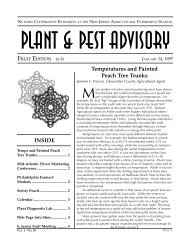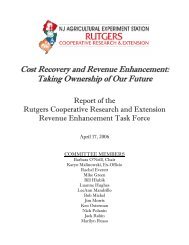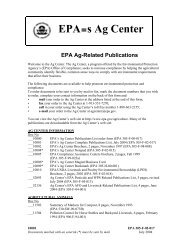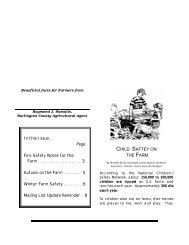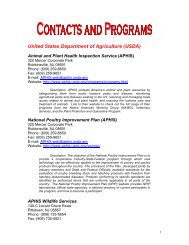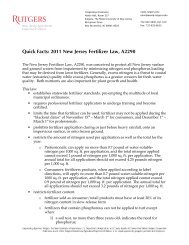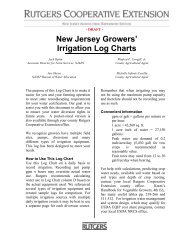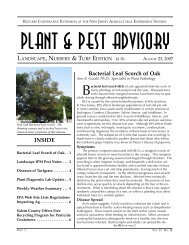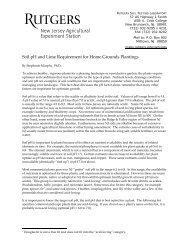View - Rutgers New Jersey Agricultural Experiment Station
View - Rutgers New Jersey Agricultural Experiment Station
View - Rutgers New Jersey Agricultural Experiment Station
Create successful ePaper yourself
Turn your PDF publications into a flip-book with our unique Google optimized e-Paper software.
IPM from page 1<br />
need for supplemental applications. Based on recent research we are placing a 100 degree day delay in the degree<br />
day table published in the Tree Fruit Production Guide. Use the following chart to time applications:<br />
Codling Moth Degree Day Timing<br />
Application and Insecticide Type<br />
County Area<br />
Rimon; Intrepid;<br />
Diamides:<br />
1250-1300DD<br />
1550-1600DD<br />
Standard Insecticides,<br />
1350DD<br />
1650-1700DD<br />
DD 1250 1300 1550 1350 1650 1700<br />
Southern 6/30 7/2 7/10 7/3 7/14 7/16<br />
Central 7/4 7/5-6 7/14 7/7 7/18 7/20-22<br />
Northern 7/7-8 7/9-10 7/20-22 7/11-12 7/25-26 7/27-29<br />
✔ Hot Weather and Sunburn: A number of apple plantings, especially in northern<br />
counties, have exhibited sunburn injury on fruit (see photo). Surround WP can be applied<br />
to mitigate this injury, but is normally used prior to the occurrence of excessive<br />
heat and sunburn conditions. Even so, use of this product may minimize further injury,<br />
especially if more heat is yet to come.<br />
Sunburn symptoms on apple.<br />
Grapes<br />
✔ Grape Berry Moth (GBM): Trap captures are picking up. The first applications<br />
for generation 2 are on July 2 nd in southern counties. This is the timing for Intrepid and<br />
the diamides. Other materials can be applied a couple of days later. On Friday newly hatched larvae were observed<br />
in low numbers feeding under the skin in Atlantic County. No injury was seen in vineyards in Gloucester County.<br />
Trap captures are increasing which maybe an indication that most mating is over. Regional differences may greatly<br />
influence insect development and may account for a slightly earlier hatch in some vineyards. A summary of the first<br />
generation flight is in the table below. This is based on the model that predicts optimal control at 810 degree days<br />
after wild grape bloom.<br />
✔ Grape Root Borer (GRB): Grape Root Borer adults have begun flying in southern counties. This has not been<br />
a major pest of commercial Vineyards in <strong>New</strong> <strong>Jersey</strong>. The following is taken from the Virginia Tech Web Site<br />
(http://www.virginiafruit.ento.vt.edu/GRB.html):<br />
“This species overwinters as larvae in two different stages of development. The life cycle takes two years<br />
to complete (some studies indicate a three-year cycle), and almost all of this is spent as larvae feeding on grape<br />
roots. They bore into the roots and crown below the soil surface, reducing the productivity of the vine. Roots may<br />
be hollowed and sometimes packed with frass. Vines eventually die; there may also be increased susceptibility to<br />
cold injury. Young larvae are spread throughout the root zone while older larvae are found on larger roots close<br />
to the trunk. Ninety per cent of the pupae are within 35 cm of the trunk and the mean depth in the soil is 9-10<br />
cm. A lack of plant vigor is usually the first sign of the presence of this pest. Another indication is the presence of<br />
cast pupal skins protruding from the soil near the base of the trunk in late July and August.<br />
Full-grown larvae are about 25 mm long, white, and have brown heads. They leave the roots and pupate<br />
in cocoons near the soil surface beginning in June. Adults emerge 35-40 days later, beginning in about the<br />
first week of July, with greatest numbers present in the last two weeks of July. Moths are wasplike in appearance.<br />
The body is generally brown. The top of the head has orange; antennae are orange with brown-black<br />
markings; the abdomen is dark brown with reddish-brown markings, with a very narrow yellow band on<br />
posterior edge of segments two, four, and sometimes on six. Legs are orange with brown-black markings.<br />
The forewings are dark and mostly opaque. The hind wing is more transparent. These moths are daytime fliers.<br />
After flying for several days, females begin ovipositing on grape foliage, canes, and weeds. Each female<br />
lays an average of 300 eggs. About two weeks after hatching, first instar larvae drop to the ground and tunnel<br />
to roots. The greatest natural mortality occurs at this point in the life cycle. Only 1.5-2.7% survive the first<br />
stage because of predation, parasitism, and desiccation; but, once established in roots, mortality is very low.<br />
Infested vines are usually encountered randomly across a vineyard. Larvae do not travel very far in the soil,<br />
usually remaining on the roots of a single vine.”<br />
See Grapes on page 3<br />
Page 2 Vol. 17 No. 14



